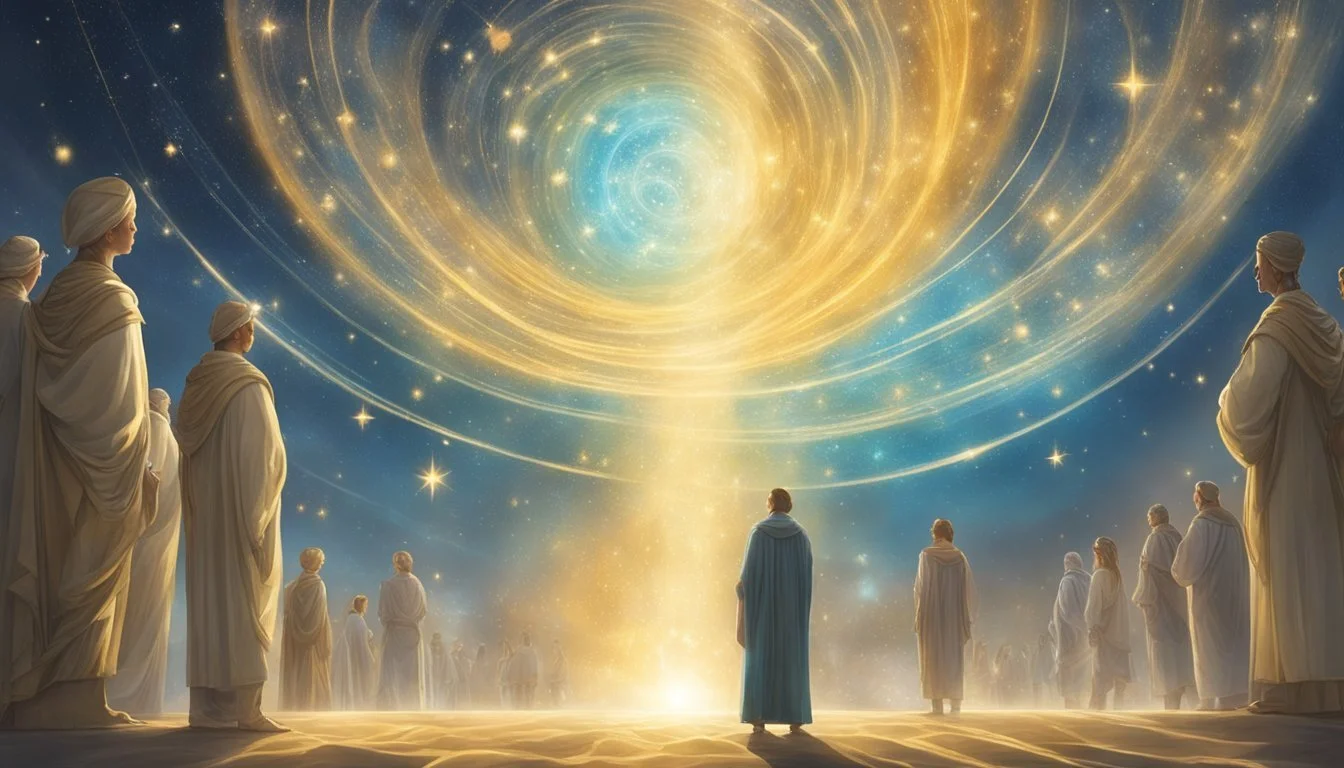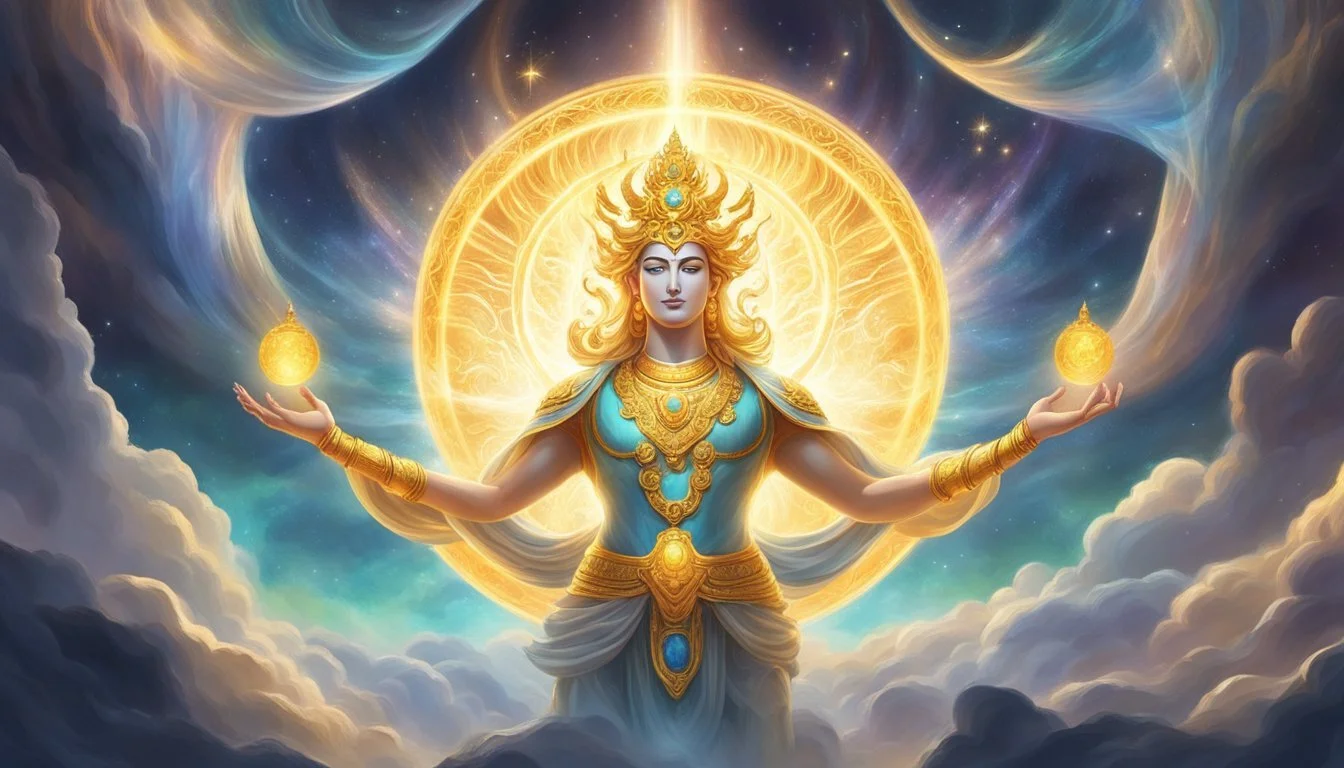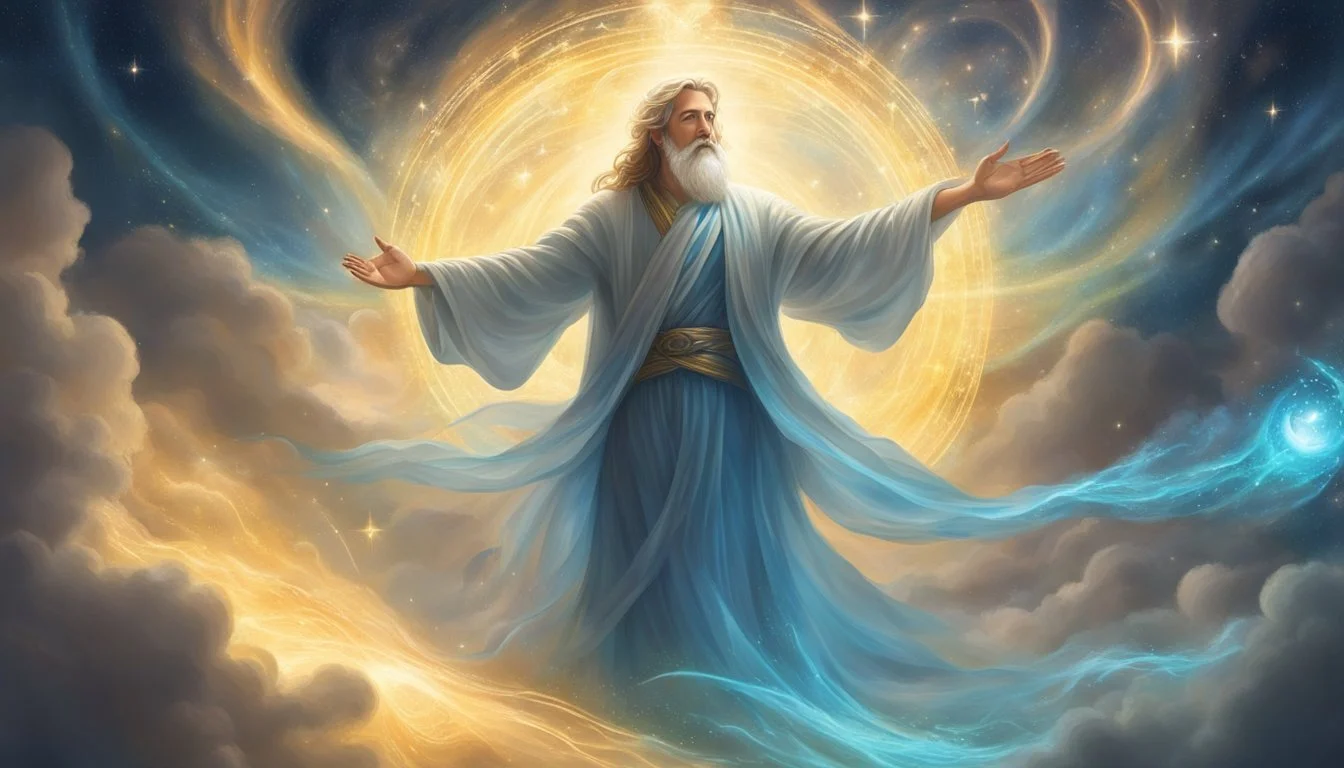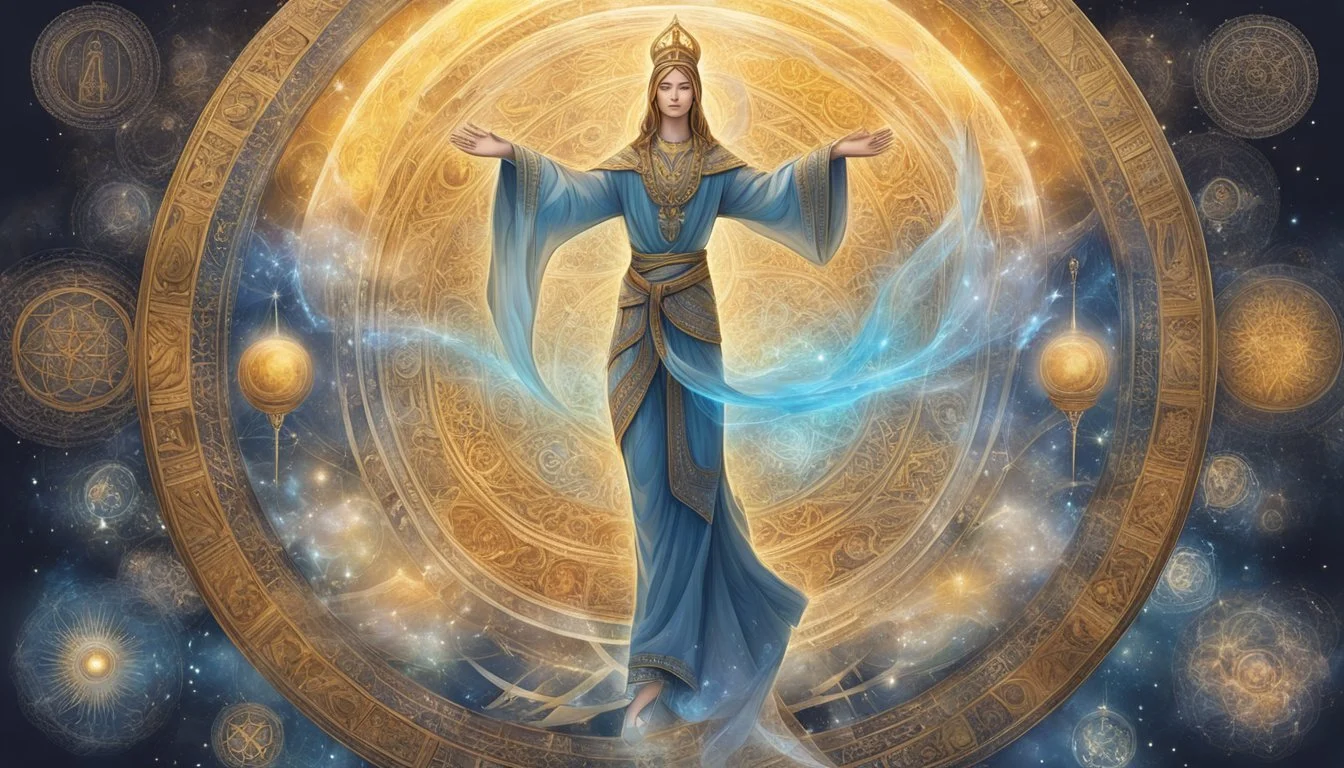Depicting the Supernatural: 'Testament's' Approach to Divine Encounters
A Visual Analysis of Religious Imagery
Divine encounters in the Bible have long captivated readers, offering glimpses into the supernatural realm where God interacts with humanity. The new series "Testament" takes a fresh approach to depicting these awe-inspiring moments on screen. By blending historical accuracy with modern cinematic techniques, "Testament" brings biblical supernatural events to life in a way that resonates with contemporary audiences.
The show draws from scriptural accounts of divine visitations, miraculous interventions, and angelic appearances. It portrays these supernatural occurrences as pivotal moments that shape the faith and destinies of biblical figures. "Testament" aims to illuminate the profound meaning behind these encounters, showing how they reveal God's character and purposes throughout biblical history.
Viewers are invited to explore the interplay between the natural and supernatural worlds as depicted in "Testament." The series uses light and visual effects to convey the transcendent nature of divine presence, while grounding the stories in authentic historical settings. This approach allows audiences to experience the wonder and significance of biblical supernatural events in a new and compelling way.
Historical Context of Supernatural Encounters
Supernatural encounters have been recorded throughout religious texts, shaping beliefs and practices across millennia. These divine manifestations played crucial roles in establishing monotheistic faiths and guiding early believers.
Old Testament Manifestations
The Hebrew Bible describes numerous supernatural events. In Genesis, God speaks directly to Adam, Noah, and Abraham. Moses encounters the burning bush and receives the Ten Commandments on Mount Sinai.
The Israelites witness divine interventions during the Exodus, including the parting of the Red Sea. Jacob wrestles with an angel, receiving a new name and blessing.
Prophets like Elijah and Isaiah experience visions and perform miracles. These encounters reinforce the covenant between God and His chosen people.
New Testament Revelations
Jesus' ministry is marked by supernatural occurrences. His birth, baptism, and transfiguration involve divine manifestations. He performs miracles, casts out demons, and rises from the dead.
The disciples receive the Holy Spirit at Pentecost, enabling them to speak in tongues. Paul's conversion on the road to Damascus is a pivotal supernatural event.
The book of Revelation presents apocalyptic visions, depicting cosmic battles and divine judgment. These experiences shape early Christian theology and practice.
Intertestamental Developments
Between the Old and New Testaments, supernatural encounters evolve in Jewish thought. Angels gain prominence as intermediaries between God and humans.
The concept of resurrection becomes more developed. Apocalyptic literature emerges, featuring cosmic visions and end-time prophecies.
Hellenistic influences introduce new ideas about the afterlife and spiritual realms. These developments bridge Old Testament traditions with New Testament theology, influencing early Christianity and later Islamic beliefs about the supernatural.
The Nature of Divine Encounters
Divine encounters in the Bible encompass various forms of communication between the divine realm and humanity. These interactions often involve profound spiritual experiences that shape individuals and communities.
Theophanies and Christophanies
Theophanies refer to visible manifestations of God, while Christophanies are pre-incarnate appearances of Christ. In the Old Testament, God appeared to Moses in the burning bush, a remarkable theophany that initiated his prophetic calling. The pillar of cloud and fire guiding the Israelites through the wilderness represents another significant theophany.
Christophanies include encounters like Joshua's meeting with the "commander of the Lord's army" before the battle of Jericho. These divine appearances often convey important messages or mark pivotal moments in biblical narratives.
Visions and Dreams
God frequently communicates through visions and dreams in scripture. The prophet Daniel received apocalyptic visions revealing future events. Joseph experienced dreams that foretold his rise to power in Egypt.
Visions can be vivid, like Ezekiel's vision of the wheel within a wheel, or more subtle, as with Peter's rooftop vision in Acts. Dreams often require interpretation, as seen with Joseph interpreting Pharaoh's dreams.
These divine revelations provide guidance, warnings, or prophetic insights to the recipients.
Supernatural Signs and Symbols
Divine encounters sometimes involve supernatural signs and symbols that convey spiritual truths. The rainbow after the flood symbolized God's covenant with Noah. The star of Bethlehem guided the wise men to Jesus.
Miraculous events like the parting of the Red Sea or the sun standing still for Joshua serve as powerful signs of God's intervention. These supernatural occurrences often accompany crucial moments in salvation history.
Symbols in visions, such as the four beasts in Daniel's prophecy, can represent complex spiritual realities or future events. Understanding these signs often requires spiritual discernment or divine interpretation.
Deities and Spirits in Ancient Texts
Ancient texts reveal a rich tapestry of supernatural beings, from powerful deities to celestial messengers and malevolent forces. These writings provide insight into how various cultures understood the divine realm and its interactions with humanity.
Angels and Demons
Angels appear in many religious texts as divine messengers and agents of God. In the Hebrew Bible, they often deliver important messages or carry out divine will.
The archangels Michael, Gabriel, and Raphael play prominent roles in later Jewish and Christian traditions. Demons, in contrast, are portrayed as evil spirits that oppose God's purposes.
Ancient Near Eastern texts depict demons as causes of illness and misfortune. Exorcism rituals aimed to drive out these malevolent entities.
Identity of God in Scripture
The Hebrew Bible presents God as the supreme creator and ruler of the universe. This monotheistic conception contrasts with polytheistic beliefs of surrounding cultures.
God is described using various names and titles, each highlighting different aspects of the divine nature. El, Elohim, and YHWH are among the most significant.
The New Testament further develops the concept of God, introducing the idea of the Trinity - Father, Son, and Holy Spirit as three persons in one divine being.
Lesser Spirits and Divine Agents
Ancient texts mention numerous lesser spirits and divine agents that mediate between gods and humans. These include:
Cherubim and seraphim: Celestial beings often associated with God's throne
Watchers: Angelic beings in Jewish apocalyptic literature
Jinn: Spirits in Islamic tradition, capable of good or evil
Some texts describe these entities as carrying out specific divine tasks or representing natural forces. Their roles often blur the lines between angels, demons, and nature spirits.
Theological Interpretations
Testament's portrayal of supernatural encounters intertwines with complex theological perspectives. Different interpretive approaches yield varied understandings of divine interactions in Scripture.
Hermeneutics and Exegesis
Hermeneutics shapes how readers interpret supernatural events in the Bible. Literal approaches take miraculous accounts at face value. Allegorical methods seek deeper symbolic meanings. Historical-grammatical exegesis examines cultural contexts.
Bultmann's demythologizing aimed to extract timeless truths from supernatural narratives. This sparked debate on balancing faith with modern worldviews. Some argue supernatural elements are integral to Scripture's message.
Diverse hermeneutical lenses produce differing views on biblical miracles and divine encounters. These interpretive frameworks influence how believers understand God's interaction with humanity.
Biblical Theology vs Systematic Theology
Biblical theology traces supernatural themes across Scripture's narrative arc. It examines how divine encounters unfold throughout biblical history. This approach highlights God's progressive revelation and covenant relationships.
Systematic theology organizes supernatural concepts into doctrinal categories. It seeks coherent explanations for miracles, angels, and spiritual realms. This method synthesizes biblical data with philosophical reasoning.
The two approaches offer complementary insights:
Biblical theology: Emphasizes historical development
Systematic theology: Focuses on logical consistency
Both contribute to a holistic understanding of supernatural elements in Scripture. They inform how Testament depicts divine encounters within a broader theological framework.
Modern Perspectives on Supernatural
Contemporary views on the supernatural range from skepticism to full acceptance. Scientific naturalism challenges traditional beliefs in miracles. Some theologians reinterpret supernatural accounts through modern lenses.
Charismatic movements emphasize ongoing supernatural experiences. They see divine healings and spiritual gifts as normative for believers today. This contrasts with cessationist views that limit miraculous events to biblical times.
Scholars like Michael Heiser propose fresh perspectives on the Bible's supernatural worldview. They explore concepts like the divine council and unseen realms. These ideas reshape how some interpret Testament's portrayal of divine encounters.
Interdisciplinary approaches integrate insights from psychology, anthropology, and neuroscience. They offer new ways to understand reported supernatural experiences without dismissing their significance for faith.
Implications for Faith and Doctrine
Testament's portrayal of supernatural events and divine encounters has profound effects on viewers' understanding of religious concepts. It shapes perspectives on salvation, judgment, and moral living within a spiritual framework.
Salvation and Redemption
Testament presents salvation as a divine gift, often accompanied by miraculous interventions. Characters experience transformative moments that highlight God's mercy and grace. These depictions reinforce the idea of redemption through faith and divine forgiveness.
The show illustrates salvation as both a personal and communal experience. Individual characters undergo spiritual awakenings, while entire communities witness God's saving power. This dual focus emphasizes the interconnectedness of personal faith and collective redemption.
Testament's narrative arc often ties salvation to characters' willingness to trust in divine guidance. This portrayal encourages viewers to reflect on their own faith journeys and the role of trust in spiritual growth.
Judgment and Divine Justice
Divine judgment in Testament is portrayed as a complex interplay of mercy and justice. The show depicts God as both a righteous judge and a compassionate father figure. This balanced representation challenges simplistic notions of divine retribution.
Characters face consequences for their actions, but the show also emphasizes opportunities for repentance and forgiveness. This approach to divine justice promotes a nuanced understanding of sin and accountability.
Testament explores the concept of divine timing in judgment. Some characters experience immediate consequences, while others face delayed judgment. This variation prompts viewers to consider the long-term implications of their choices and the patience of divine justice.
Morality and Spiritual Discipline
Testament emphasizes the importance of moral living and spiritual discipline in the face of supernatural challenges. Characters who maintain their integrity often receive divine support, illustrating the link between faith and ethical behavior.
The show presents spiritual disciplines like prayer, fasting, and meditation as practical tools for strengthening faith. These practices are depicted as sources of guidance and strength during times of trial.
Testament explores the tension between human weakness and divine expectations. Characters struggle with moral dilemmas, showcasing the ongoing nature of spiritual growth and the need for perseverance in faith.
Comparative Religious Perspectives
Religious traditions worldwide offer diverse perspectives on supernatural encounters and divine manifestations. These views shape how different faiths approach and interpret extraordinary experiences.
Abrahamic Religions on the Supernatural
Judaism, Christianity, and Islam share a belief in one God who interacts with humanity. In Judaism, divine encounters often involve visions or dreams, as with Moses and the burning bush. Christianity emphasizes Jesus as God incarnate, with miracles and the resurrection as key supernatural events.
Islam focuses on Muhammad's revelations from Allah through the angel Gabriel. All three religions recognize angels, demons, and spirits as supernatural beings. The Catholic Church has formal processes for verifying miracles and supernatural occurrences.
Monotheistic faiths generally view supernatural events as rare but meaningful signs from God. They often interpret such experiences within their theological frameworks.
Eastern Traditions: Hinduism and Buddhism
Hinduism embraces a rich tapestry of supernatural elements. Gods and goddesses frequently interact with humans in Hindu scriptures. Spiritual practices like yoga and meditation aim to connect practitioners with divine realms.
Buddhism takes a different approach. While acknowledging supernatural beings, it focuses more on personal enlightenment. Buddhist traditions vary in their emphasis on supernatural elements. Some branches incorporate local deities and spirits.
Both Hinduism and Buddhism view supernatural experiences as part of a broader spiritual reality. They often interpret these events as reflections of inner states or cosmic truths.
Supernatural in Modern Religious Practice
Contemporary religious practices continue to engage with supernatural concepts. Many believers across faiths report personal encounters with the divine. These experiences range from subtle intuitions to dramatic visions.
Spiritual practices like prayer and meditation remain central for accessing supernatural realms. Some modern movements blend traditional beliefs with new interpretations of the supernatural. Others focus on personal growth and inner spirituality.
Scientific studies examine the neurological and psychological aspects of reported supernatural experiences. This research offers new perspectives on age-old religious phenomena.
Influence on Cultural Narratives
'Testament' has shaped how divine encounters are portrayed across various art forms and media. Its approach to depicting supernatural elements has left a lasting impact on cultural narratives.
Artistic Depictions of the Divine
Visual art has long grappled with representing the divine. 'Testament' influenced many artists' conceptions of God, angels, and demons. Renaissance painters like Michelangelo drew inspiration from biblical descriptions when creating their frescoes and sculptures.
Modern artists continue to explore supernatural themes through abstract and surrealist works. Some focus on light and darkness as symbols of good and evil. Others attempt to capture the essence of spirit through ethereal imagery.
Digital art and special effects in film have opened new possibilities for visualizing the divine. CGI allows for spectacular renderings of heavenly realms and otherworldly beings.
Literature and Supernatural Themes
'Testament' has been a wellspring of inspiration for writers exploring supernatural themes. Many fantasy and science fiction authors incorporate divine encounters into their world-building.
C.S. Lewis's 'Chronicles of Narnia' features Aslan as a Christ-like figure. Philip Pullman's 'His Dark Materials' trilogy reinterprets religious concepts through a fantasy lens.
Horror literature often draws on demonic imagery from religious texts. Supernatural thrillers frequently pit human protagonists against angelic or demonic forces.
Contemporary fiction continues to grapple with questions of faith and the nature of divinity. Authors explore the concept of humans as made in God's image through complex characters and moral dilemmas.
Media Representations and Symbolism
Television and film have brought supernatural narratives to wider audiences. Shows like 'Supernatural' and 'Good Omens' blend religious lore with popular entertainment.
Biblical epics remain a staple of Hollywood, offering grand visions of divine intervention. These films often use light and shadow to convey spiritual concepts visually.
Video games allow players to interact with divine beings and navigate moral choices. Some games incorporate religious symbolism into their design and storytelling.
Social media and internet culture have spawned new forms of engagement with supernatural themes. Memes and viral content often remix religious imagery for humorous or thought-provoking effect.
Conclusion
"Testament" offers a unique portrayal of supernatural encounters in biblical narratives. The series brings divine visions and revelations to life through compelling visual storytelling.
By depicting these encounters, "Testament" invites viewers to contemplate the transformative power of divine presence. It illustrates how biblical figures were changed by their experiences with the supernatural.
The show's approach balances reverence for sacred texts with creative interpretation. This allows audiences to engage with familiar stories in new ways, potentially deepening their understanding of biblical themes.
"Testament" also explores the concept of belief, showing how characters grapple with the meaning of their supernatural experiences. This adds depth to the portrayal of faith journeys.
Through its depiction of divine encounters, the series highlights the enduring fascination with the supernatural in religious narratives. It demonstrates the continued relevance of these ancient stories in contemporary media.








